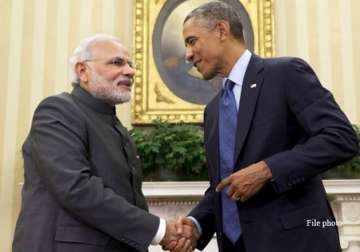India and US: The best is yet to be
President Barack Obama's presence at the Indian Republic Day celebrations Jan 26 will mark the highest point in Indo-American relations.What lends special significance to the occasion is that the US president will spend nearly two

President Barack Obama's presence at the Indian Republic Day celebrations Jan 26 will mark the highest point in Indo-American relations.
What lends special significance to the occasion is that the US president will spend nearly two hours in the open with his Indian hosts. Normally, the US Secret Service is wary of such a long exposure for their chief executive. The maximum time which he generally spends outdoors is a little over an hour during the oath-taking ceremony.
It is obviously the importance which Obama attaches to the Indian connection which has made the security agencies shelve their reservations.
Their willingness to make an exception on January 26 is all the more significant in these unpropitious times when the ever-present threat of terrorism has been accentuated by the murderous assaults on journalists in Paris.
No one knows better than those in charge of guarding the heads of nations that no amount of scrutiny of the visitors or the stationing of sharp-shooters on rooftops or the closing of the airspace over the venue is enough to keep danger at bay if a terrorist is prepared to die while targeting his perceived enemy.
So, it is not only Delhi's polluted air - about which concerns have also been expressed by the Americans - which is a cause for worry, but the possibility that the psychopathic killers in Pakistan will be loathe to miss an opportunity when the man they love to hate will be a sitting target for a prolonged period.
However, if the hosts and their honoured guest have chosen to overlook these obvious concerns, the reason is the upturn that has taken place between the world's oldest and largest democracies in recent years.
For many, the two should have been natural allies for years together. But, the compulsions of international relations and the varying perceptions of ideology kept them apart.
While Washington's preoccupation with the menace of communism and, especially, its use of Pakistan as a tool to counter it, created a barrier between the US and India, the dominance of capitalism in the former and India's preference for a “socialistic pattern of society”, as a Congress party resolution said in 1955, was another factor behind the souring of relations.
Even when the ties began to improve in the aftermath of then prime minister Manmohan Singh's initiative to reach an agreement on a nuclear deal that ended India's ostracism from the nuclear club of the Big Five after the Pokhran implosion in 1974, the fact that there was hesitation in India about moving close to the US was evident from several reactions.
One of these was the opposition of a section of strategic analysts who were against the opening up of India's nuclear installations to outside inspection. But, the most crucial was the observation of Congress president Sonia Gandhi that the communists had a point in criticizing the deal.
Arguably, India-US relations hung by a thread at that point of time in 2008 when the Manmohan Singh government faced a no-confidence motion in parliament. If the government had fallen, it would have been back to the days of former US secretary of state John Foster Dulles, whose telling phrase - if you are not with us, you're against us - was a warning to India about its non-alignment policy of maintaining equidistance from the two superpowers of the time.
Thankfully, the clouds passed. Besides, the realization dawned in Washington that it could not allow a “failed state” like Pakistan to embitter its ties with New Delhi.
Two of Obama's predecessors also played a seminal role in improving Indo-US relations. One was Bill Clinton's rejection of Pakistan's efforts to redraw the borders in Kashmir with blood. Up to that point, the belief in the US was that all would be well only if India handed over Kashmir on a platter to Pakistan.
But, Pakistan's reputation as an epicentre of terrorism was a reminder that redrawing the boundaries would only extend the “backyard” where Islamabad kept its “snakes”, to quote Hillary Clinton.
The other president who recognized India's distinctiveness was George W. Bush, who marvelled at the fact that there were virtually no Indian Muslims in Al Qaeda. Clearly, Indian democracy had given enough hope to the minorities to persuade them to shun extremism.
Obama and Prime Minister Narendra Modi can be said, therefore, to be carrying forward what Bush and Manmohan Singh started. Moreover, Modi is fortunate in that he doesn't have anyone in his party who will try to undercut his initiatives.
Ideologically, too, India is today closer to the US than ever before. Capitalism is no longer a cuss word in Indian political circles, where chief ministers are virtually competing with one another to invite the domestic and foreign private sector to invest in their states.
While Pakistan is falling off the map, its all-weather friend, China, may be realizing that India is not quite the pushover that it used to think. Nor is America an unsteady giant. Its technological prowess will continue to give it an edge over the pretentious Middle Kingdom.
For India and the US in the 21st century, the best is yet to be.